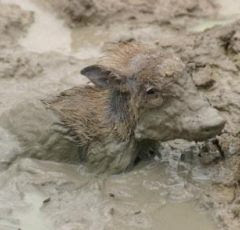There are safe and sane solutions. The one we'll focus on today is 'The Perennial Solution'. As Richard Westwood, professor of environmental science and studies with the University of Winnipeg says, "The tall grass prairie which once extended from Canada all the way down to Texas is probably the most threatened ecosystem in North America. There is only about one per cent of it left."
The annual grains that government subsidized corporate agriculture grows on what was once the tall grass prairie create many problems including the run off of chemical fertilizers and pesticides into our watersheds, the consumption of huge quantities of fossil fuel products, the overuse of our limited fresh water resources and the direct emission of billions of tons of carbon that was safely sequestered in the living soil's biomass. The thrifty perennials, with their long roots hold on to soil, water, and fertilizer, which means less of all types of pollution including carbon pollution of the atmosphere.
Modern industrial agriculture has in a few decades done as much harm to the health our global atmosphere as it has to the health of the humans who consume its toxic products. Research shows that perennial grasses sequester carbon. "Soils are like a bank account. You should only draw out what you put in." says Rattan Lal of Ohio State University, “Keeping and putting carbon in its rightful place needs to be the mantra for humanity if we want to continue to eat, drink and combat global warming, concluded 200 researchers from more than 30 countries."
Organizations like the American Grassfed Association and its members like Martha Holdridge, owner of West Wind Farm, who used soil samples to determine that her West Virginia farm sequestered 15 tons of CO2 per acre over the past four years know the truth.
Wes Jackson's Commencement Address at University of Kansas this spring focused on The Land Institute who's scientists have proved that agricultural landscapes that absorb greenhouse gases, protect soil, water, and air can feed us profitably. Wes's institute is working to perennialize major crops and domesticate some promising wild species like Kernza, a relative of wheat and other grasses, on their Salina Calif. experimental farm and in Minnesota. They are also working on the perennialization of upland rice in China.
Ted Turner is another inspiring individual who is putting his money where his mouth is by buying up huge tracts of tall grass prairie that has been destroyed by industrial agriculture and is successfully returning it to its former fertility in conjunction with re-establishing and expanding one of the few remaining genetically pure bison herds on his 500,000 acres [or more, it grows constantly].
As these examples illustrate that a few individuals can, and are, starting without government grants or permission to use the tools of our regenerative Mother Earth freely provides for re-building soil carbon sequestration through the re-establishment of perennial grasses.
Restoration of North America's tall grass prairie ranches can become a significant sink for the sequestration of existing greenhouse gasses, literally sucking excess greenhouse gases out of the atmosphere and sequestering them safely in the soil, where they belong. A shift from seed grains to perennial grasses would, over time, re-sequester those 100 billion tons of excess carbon in our atmosphere and as Ted Turner is busy demonstrating and lecturing about, make a profit doing it. Please check out this awesome library and its links that lead to the research results and conclusions drawn from those results by some of the world's leading scientists.
"Treat the earth well: it was not given to you by your parents, it was loaned to you by your children. We do not inherit the Earth from our ancestors, we borrow it from our children."
-Ancient Indigenous Proverb
-Ancient Indigenous Proverb



